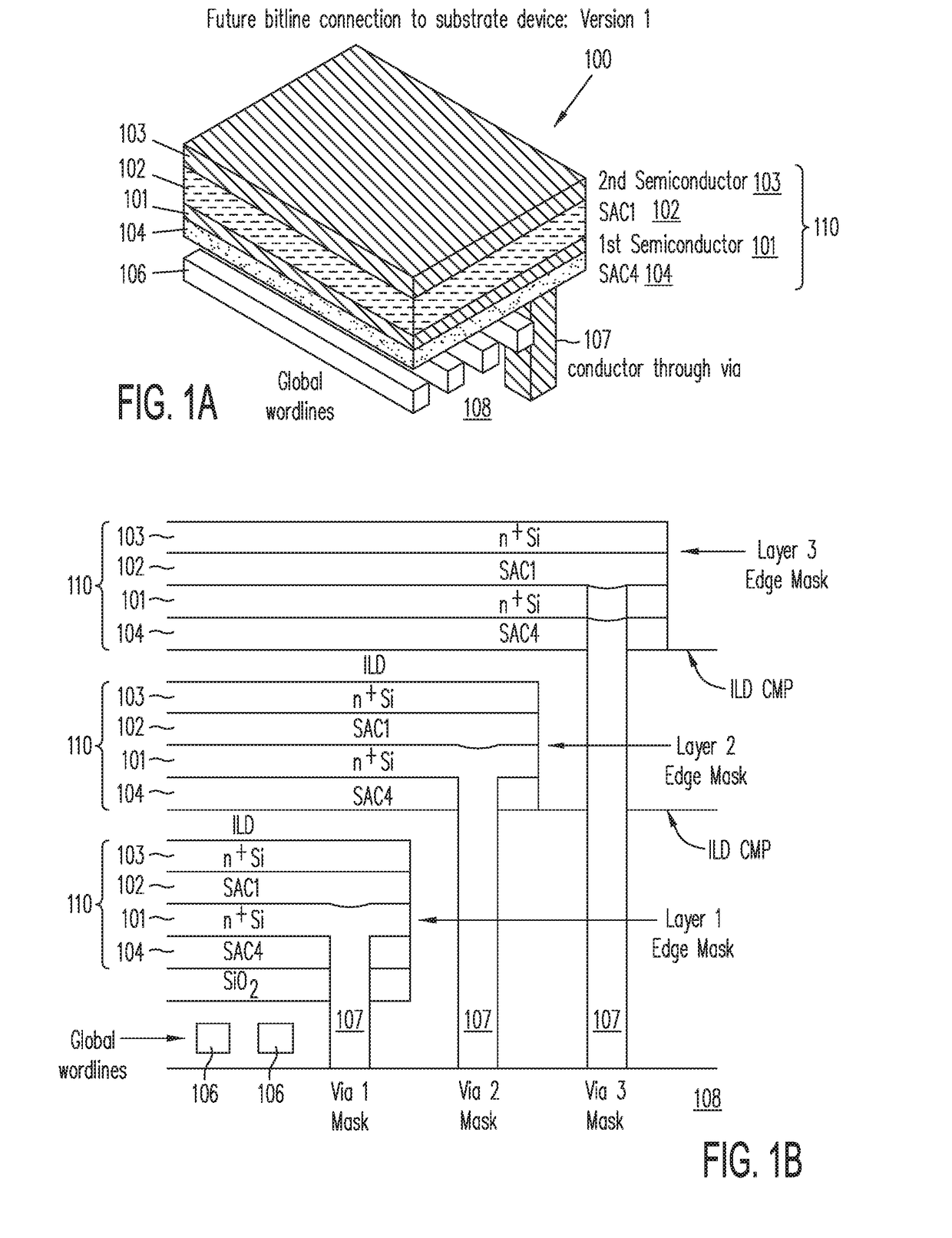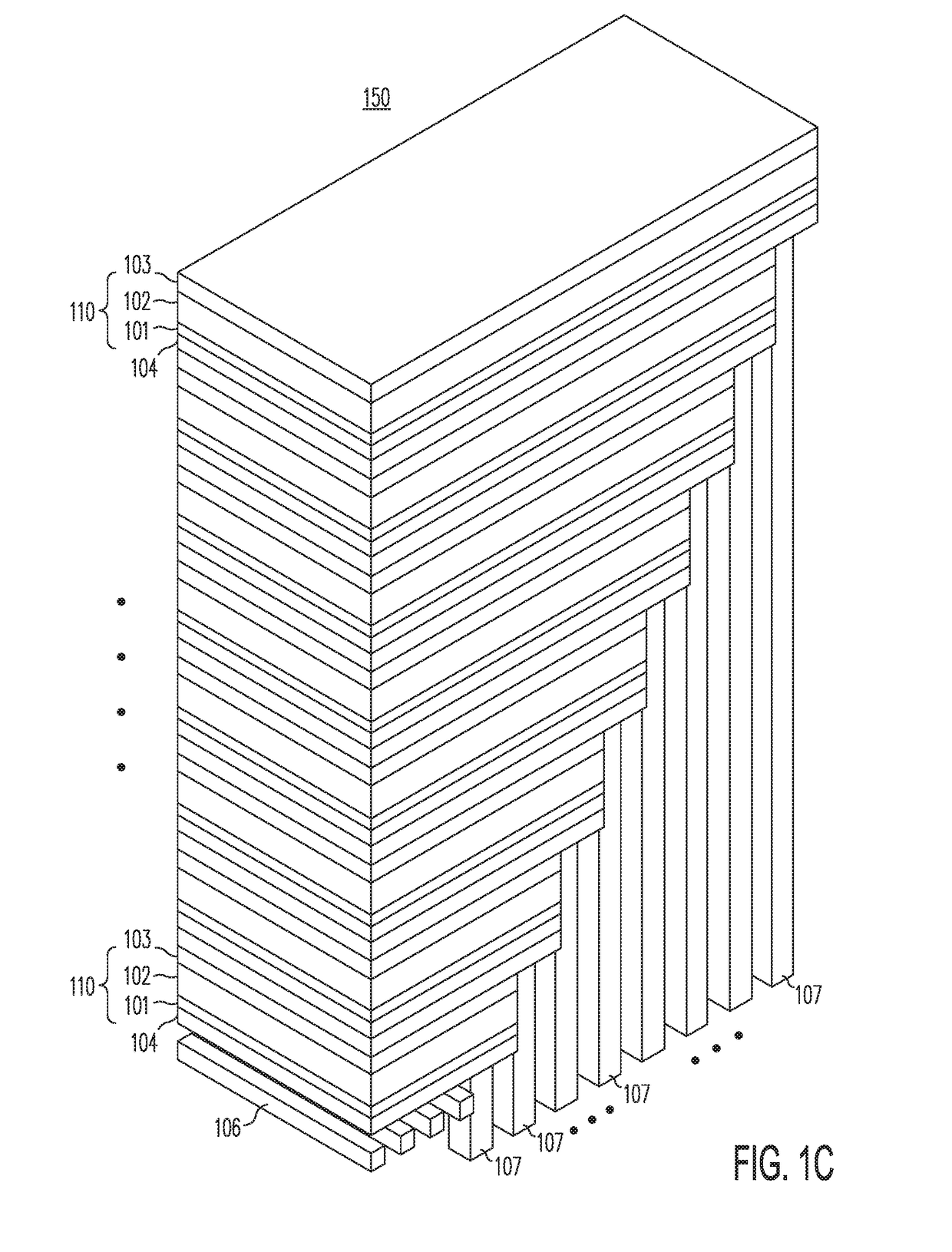3-Dimensional NOR Memory Array Architecture and Methods for Fabrication Thereof
a technology of memory arrays and layers, applied in semiconductor devices, semiconductor/solid-state device details, instruments, etc., can solve the problems of difficult etching in 3 and undesirable removal of masking layers or layers before etching target materials, and increase the difficulty of etch selectivity, etc., to achieve low cost, mechanical stability, and low resistance metal interconnections
- Summary
- Abstract
- Description
- Claims
- Application Information
AI Technical Summary
Benefits of technology
Problems solved by technology
Method used
Image
Examples
embodiment 1
[0084]In this embodiment, tall memory structures with large aspect ratios are achieved using reinforcing struts. The high aspect ratio structures are created after the precursor structures are stabilized by a system of strut structures, and one or more sacrificial layers (“SAC4 sublayers”) are removed by one or more etching steps into the exposed sidewalls of trenches through the NIN stack.
[0085]FIG. 2A shows a cross-sectional schematic of various material layers in memory structure 500, according to one embodiment of the present invention. In FIG. 2A, active layers 502-0 to 502-7 each include drain sublayer 523, source sublayer 521 and sacrificial material 1 (“SAC1”) sublayer 522 (to be subsequently wholly or partially replaced by a channel material sublayer). In addition, sacrificial material 4 (SAC4) sublayer 524 is provided, to be subsequently replaced by a conductive sublayer which electrically contacts drain sublayer 523 substantially throughout its entire length. FIG. 2B show...
embodiment 2
[0104]In this embodiment, the SAC4 material-containing sublayer or sublayers (e.g., second sacrificial sublayers 304a and 304b of FIG. 7), are removed by etching long cavities in the direction along the length each sublayer, instead of side-ways (i.e., in the direction along its width) through exposed portions from side walls of the trenches, as was shown above in conjunction with FIGS. 6-7 (Embodiment 1) above. In other words, etchant sequentially removes SAC4 material from one or both ends along the length of the second sacrificial sublayer or sublayers. While this etch takes longer paths, Embodiment 2 has an advantage over Embodiment 1 in that metal replacement may be carried out after the memory cells have been formed, thereby reducing the risk of metal contamination in the memory cells.
[0105]FIG. 13 shows memory structure 400 that is substantially the same as the memory structure 300 of FIG. 11, except for removal of second sacrificial sublayers 304a and 304b and metal replacem...
embodiment 3
[0111]Alternatively, the NIN stacks can be built incrementally in two or more portions. In each portion, only a limited number of active layers are etched in the vertical direction. Specifically, etching of high aspect ratio NIN stacks are avoided in the initial portion (portion 1) by etching fewer active layers, which reduces the aspect ratio. When a subsequent portion of the NIN stacks is added on top of an earlier portion of the NIN stacks and etched, the earlier portion is supported by a dielectric layer that is deposited in the trenches of the earlier portion. The subsequent portion is self-supporting during its etch, as the etch does not create a high aspect ratio structure. When all the portions of the NIN stacks have been fabricated, a dielectric layer is deposited to fill any remaining open trenches, patterned, and etched to remove all previously deposited like dielectric layers from all earlier portions of the NIN stacks, while maintaining the mechanical strength of the NI...
PUM
| Property | Measurement | Unit |
|---|---|---|
| thickness | aaaaa | aaaaa |
| thickness | aaaaa | aaaaa |
| aspect ratio | aaaaa | aaaaa |
Abstract
Description
Claims
Application Information
 Login to View More
Login to View More - R&D
- Intellectual Property
- Life Sciences
- Materials
- Tech Scout
- Unparalleled Data Quality
- Higher Quality Content
- 60% Fewer Hallucinations
Browse by: Latest US Patents, China's latest patents, Technical Efficacy Thesaurus, Application Domain, Technology Topic, Popular Technical Reports.
© 2025 PatSnap. All rights reserved.Legal|Privacy policy|Modern Slavery Act Transparency Statement|Sitemap|About US| Contact US: help@patsnap.com



